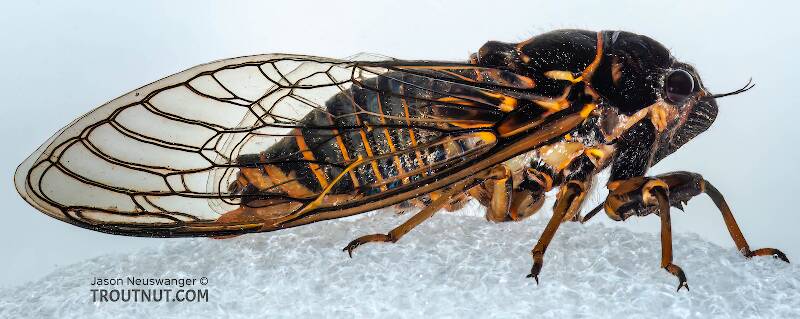
Hex Mayflies
Hexagenia limbata
The famous nocturnal Hex hatch of the Midwest (and a few other lucky locations) stirs to the surface mythically large brown trout that only touch streamers for the rest of the year.
Featured on the forum

Nymphs of this species were fairly common in late-winter kick net samples from the upper Yakima River. Although I could not find a key to species of Zapada nymphs, a revision of the Nemouridae family by Baumann (1975) includes the following helpful sentence: "2 cervical gills on each side of midline, 1 arising inside and 1 outside of lateral cervical sclerites, usually single and elongate, sometimes constricted but with 3 or 4 branches arising beyond gill base in Zapada cinctipes." This specimen clearly has the branches and is within the range of that species.

Troutnut is a project started in 2003 by salmonid ecologist Jason "Troutnut" Neuswanger to help anglers and
fly tyers unabashedly embrace the entomological side of the sport. Learn more about Troutnut or
support the project for an enhanced experience here.
True Bug Family Cicadidae (Cicadas)
Though they aren't aquatic, cicadas can end up on the surface of trout streams in great numbers in the rare years when they swarm our forests by the tens of millions. It stands to reason that trout would gorge themselves on cicadas at such times, and I have heard reports of it but never been lucky enough to witness the "cicada hatch" myself.
Specimens of Cicadas:
1 Adult

I found this cicada and several like it in the grass near my car as I put my waders on. Some of them were singing in the trees above the river, too, but I did not see any fall into the water.
Discussions of Cicadidae
DO You Remember???
6 replies
Posted by JANNEY on Jan 4, 2007
Last reply on Feb 7, 2007 by Konchu
My brother and I have a disagreement about bugs from our childhood.
I remember a swarm of cicadas (17-year locusts), and I'm trying to place the year. It would be 1954 to 1959, I believe. I remember the cicadas' distinctive call ringing through the summer (spring?) night. They covered anything that shed light—lampposts, storefront windows, porch lights. They were about in huge numbers. When you walked down the street, you couldn't avoid stepping on them, and they crunched. (Big bugs.)
My brother says he only recalls a mayfly swarm—post 1959—that was so bad it caused auto accidents on the freeway because cars ran over the mayfly bodies and collectively they were greasy and caused cars to skid.
So does anyone out there remember either of these events. I think both probably occurred. We'd like to pin down the years.
Janney
I remember a swarm of cicadas (17-year locusts), and I'm trying to place the year. It would be 1954 to 1959, I believe. I remember the cicadas' distinctive call ringing through the summer (spring?) night. They covered anything that shed light—lampposts, storefront windows, porch lights. They were about in huge numbers. When you walked down the street, you couldn't avoid stepping on them, and they crunched. (Big bugs.)
My brother says he only recalls a mayfly swarm—post 1959—that was so bad it caused auto accidents on the freeway because cars ran over the mayfly bodies and collectively they were greasy and caused cars to skid.
So does anyone out there remember either of these events. I think both probably occurred. We'd like to pin down the years.
Janney
Start a Discussion of Cicadidae
References
- Baumann, Richard W. 1975. Revision of the Stonefly Family Nemouridae (plecoptera) : a Study Of The World Fauna At The Generic Level. Smithsonian Contributions to Zoology undef(211): 1-74.

